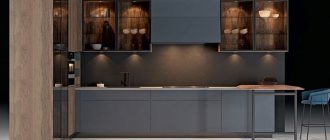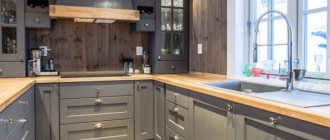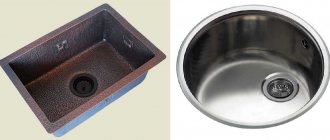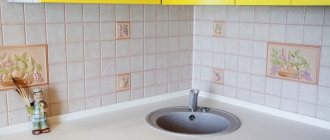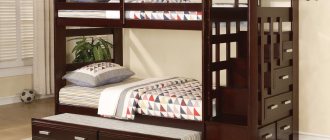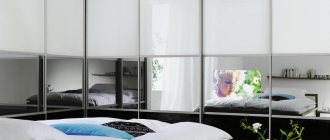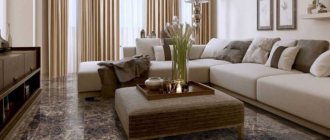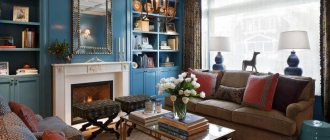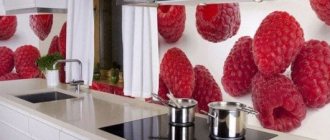A good kitchen set is the key to convenience and quality food preparation. This process is accompanied by high temperatures and humidity; not all furniture can withstand such loads. In addition to the practical side, external attractiveness is also important: often this is where guests are received or gathered for a family dinner. In this article we will tell you which kitchen façade material to choose in order to combine practicality and beauty.
Types and forms
The classification of kitchen cabinet furniture facades involves dividing them into different types depending on the material used, manufacturing technology and the shape given. Depending on the manufacturing method, the facades can be...
Whole
A solid fabric is used to make the facade. They have a flat, smooth surface, different colors, can be smoothly colored or printed, decorated with overlays, and are shaped – straight or rounded. Caring for them during operation is not difficult.
Framework
This facade is made using 2 harmoniously combined materials and consists of a frame and filler, for example, wood + glass, metal + glass, metal + plastic, MDF + carved wood panels. They can be rectangular or rounded. Caring for the surface of frame facades is not difficult.
Paneled
Such a facade has a rectangular shape and consists of a frame, panels and glass, stained glass and other types of inserts. Due to the many small parts, paneled fronts require more time to clean.
The selection of color and stylistic solutions for kitchen cabinet furniture is made taking into account the overall style of the interior.
Lighting requirements
Warm soft light is most suitable for natural wood.
Simple lampshades or sconces can most optimally accentuate the beauty of furniture facades, which should become one with the kitchen design.
Straight kitchen design with cabinets up to the ceiling- What material are kitchen sets made of?
Design of a narrow kitchen: photos of beautiful interiors + designer tips
Popular materials
The materials used for the manufacture of kitchen facades must be moisture-, heat- and wear-resistant. The choice of a specific material determines the style of the entire interior.
Wooden facades
They look respectable and beautiful. Expensive sets are made of solid oak or beech, walnut, cherry, ash, and other hard and semi-hard woods. They are painted in various - most often natural - shades, covered with varnish and patina. Since wooden facades are valued for their texture and natural pattern, they are mainly made solid, without decorations or decorated with false panels and carvings.
Solid facades made of natural wood look good in large kitchens; they are durable, environmentally friendly, resistant to mechanical damage, and can be restored.
A significant disadvantage of such facades is their high cost, instability to prolonged exposure to moisture or steam, and the need for delicate care. A more affordable wooden facade is paneled and framed, as well as made from multiplex.
Facades made of artificial stone
Attractive and varied in color and shape, they have excellent performance qualities. They are hygienic, wear-resistant, moisture- and heat-resistant, being solid - easy to care for, and have virtually no flaws.
Metal facades
Made from aluminum or stainless steel. The noble metallic luster and unlimited service life have made them quite popular. Metal frame facades look original and very modern. They use an aluminum profile as a frame, and the filling is glass, glass laminate, mirrors, MDF, rattan, stained glass, and plastic.
MDF facades
Using MDF for the manufacture of kitchen facades allows you to realize any ideas. Due to the high plasticity of the material, facades can be given a rectangular, rounded, convex or concave shape. Facades made from this material are environmentally friendly, aesthetically pleasing, affordable and practical.
Depending on the coating used, they can be:
- Painted in any colors. The surface of such facades can be matte or have an attractive glossy, pearlescent, metallic sheen;
- Covered with printed or plain, matte or glossy PVC film;
- Lined with colored plastic imitating various surfaces - aged, cracked, marble, stone, silk and others;
- Lined with veneer, giving them the appearance of valuable wood;
- With an acrylic coating that creates a deep, extra-glossy effect. Such facades are very attractive in appearance, capable of visually increasing space, but are quite difficult to maintain.
A common disadvantage of almost all types of MDF, with the exception of those lined with plastic or coated with acrylic, is instability to ultraviolet radiation and mechanical damage - scratches and chips.
Important! In terms of strength, the facades of kitchen cabinet furniture made from MDF are not inferior to wooden ones.
Plastic facades
Versatile and unpretentious, resistant to mechanical scratches, moisture and sun, available in a variety of color variations.
Chipboard facades
They are popular due to their affordable cost, but due to their sensitivity to prolonged exposure to temperature, steam and water, they quickly become unusable and therefore rather impractical. For facades, moisture-resistant chipboard is usually used, which can be distinguished by its cut. Moisture-resistant chipboard has a greenish tint, while regular chipboard has a grayish tint. Kitchen furniture made of laminated chipboard is mainly justified in rented apartments.
Glass facades
Made from tempered colored, transparent and frosted glass, triplex or float glass, they can be frameless or framed. Additionally, they are decorated with laminate, sandblasting, photo printing, and equipped with lighting. Kitchen facades made of glass are environmentally friendly, practical and durable, but if damaged, they cannot be restored.
Each of the materials currently used for the manufacture of kitchen facades has its own advantages, providing ample opportunities for the implementation of design solutions. The main factors influencing the choice of a particular material are its cost and the general style of the kitchen interior.
Acrylic MDF
These products with a pleasant glossy surface are made using the same technology as plastic ones - an MDF board is covered with a thin layer of acrylic.
Photo from source: znakotveta.ru
Tabletop Cedar 3043/S Semolina gray
Advantages
- does not peel off;
— deep mirror gloss effect;
- not susceptible to fading when exposed to direct sunlight;
— manifestation of resistance to chips and other types of damage;
- strength.
Flaws
— all prints and stains are clearly visible, so special care is required;
- impossibility of milling.
Features of caring for kitchen facades
The service life and preservation of the appearance of kitchen cabinet furniture directly depend on the characteristics of its operation and care of the facades. When installing wall-mounted modules, you should follow the recommendations for the height of the location above stoves and sinks. To avoid scratches, do not use hard scrapers or abrasive detergents to care for kitchen surfaces.
- Cleaning of sets made of natural wood is carried out only with the use of soft rags and gentle products that do not leave streaks on the surface and special waxes.
- To care for glossy MDF facades, it is recommended to use microfiber rags, special polishing mixtures and soap-based detergents that do not contain abrasive particles, ammonia and chlorine components.
- Plastic and laminated chipboard facades are durable and more resistant to scratches, they can be easily cleaned with any slightly alkaline soft products without alcohol, chlorine and abrasives, and treated with special polishes to add shine.
Important! When choosing a polishing agent for kitchen plastic and laminated facades, you should use only those that are approved for treating surfaces in contact with food.
- Steel or aluminum surfaces should be cleaned with products that do not contain solvents, acids or alkalis. At the end of cleaning, polishing the metal surfaces with a dry soft cloth will add shine.
- Glass facades can be easily washed with glass cleaners and polished with a dry cloth.
- Artificial stone facades can be cleaned with woven cloths, melamine sponges and any detergents; the use of abrasive and chlorine-containing detergents is acceptable.
What is the choice based on?
A kitchen is a room that cannot provide furniture in good conditions, simply because food is prepared here. Consequently, the humidity here will always be at an elevated level, as will the air temperature, as well as its sudden changes, the presence of soot in the air, flying drops of fat, and the risk that aggressive liquids will reach the surface. In order for a kitchen set to last for a really long time, you need to choose a material that can successfully withstand all this.
Photo from source: hoog.design
Table top Cedar 706/S Royal opal
Combination of facades and interior styles
The style of the kitchen interior depends solely on the desire and taste of the owner. To achieve the best results, it is recommended to take into account the features of combining facades with the overall style.
Dark and light wooden facades traditionally decorate kitchens made in the baroque, modern, chalet, eco-style, country and its varieties - Scandinavian, English, American, Provence, rustic. They will fit perfectly into a kitchen interior designed in a classic, art deco or vintage style.
MDF facades are used to create kitchen interiors in modern, country, as well as Japanese or Chinese styles. Laminated chipboard facades are used to create kitchen interiors in modern, vintage, minimalist and modern styles. Plastic facades are versatile and unpretentious, they look good in classic and modern kitchens. With their help it is easy to realize design ideas in fusion or high-tech style.
The noble laconicism of kitchen sets with metal or framed facades looks harmonious in modern kitchen interiors. The combination of an aluminum frame and glass is typical for hi-tech and techno, but for modern, a combination consisting of an aluminum profile and frosted glass and an aluminum profile and brightly colored MDF is more suitable.
Glass facades are traditionally used to create a kitchen in a modern, loft or high-tech style.
Color solutions for facades
The color schemes of the facades set the tone for the entire interior, so a competent approach to their choice is of paramount importance. One of the most important rules is the harmony of cold and warm shades. Disruption of this balance causes discomfort. Dark facades look good in large, spacious kitchens, while light ones look good even in small spaces.
You should not match the facades to the walls, otherwise they will get lost. It is better if the kitchen set is a couple of shades darker, and contrasting accents are implemented using a countertop, wall panel or textiles. To avoid boredom in monochromatic interiors, use 2-3 shades of the same color or use a base color on objects with different textures.
The light, pastel colors of facades made of wood or laminated chipboard require bright accents that can be placed using textiles in rich colors. Neutral colors - white and black, are successfully implemented in glass and MDF facades. Popular color combinations are gray and orange, black and red, made in plastic and MDF facades.
When choosing stone facades, you should avoid monochrome shades, since dirt, scratches and other defects are clearly visible on such surfaces. The best solution would be facades in light pastel shades with large inclusions. It is recommended to support steel or aluminum facades with a monochrome interior.
Attention! When choosing facades, you should not forget about kitchen frames. They must be chosen either tone on tone or in contrast, otherwise bad taste is guaranteed.
Kitchen-living room: mastery of camouflage
With the fashion for open space, the kitchen is increasingly becoming part of the living room. And to prevent the unsightly cooking area from bringing disharmony into the interior, a practical solution was found - folding swing and slide doors. They hide in niches on the sides of the linear kitchen and, if necessary, easily move out and cover the work surfaces from prying eyes.
Folding doors are a good option for small kitchens in studios
Another kitchen object that is subject to secrecy is the hood. It is fashionable to hide it not on top, as before, but directly in the hob. It extends only during cooking, working through a filter or communications. And then the structure automatically retracts down into a special niche, leaving the surface smooth.
Retractable apron and hood built into the kitchen from the Miro brand
How much do facades cost?
The cost of facades is influenced by the material from which they are made and the design solution. The most expensive and prestigious are facades made of solid oak and other valuable tree species. Facades made of wooden panels and soft wood are cheaper.
Glass and metal facades, as well as those made of artificial stone, are distinguished by their high cost. If you really like stone facades, but have a limited budget, you should pay attention to stone facades with small inclusions - they are cheaper than those with large inclusions or stains imitating natural stone.
MDF facades are affordable, although there are price gradations among them. Veneer facades are the most expensive, a little more affordable are those made of painted MDF lined with plastic or acrylic, and the cheapest are film ones. Speaking about affordable prices, we cannot fail to mention facades made of laminated chipboard. They are the most budget-friendly.
The absence of strict rules when choosing facades allows you to realize even your wildest fantasies, combining shades and textures in an innovative way. The main thing, in addition to your own preferences, is to take into account the requirements that kitchen furniture must meet, then it will last for many years.
PVC coated MDF
They have the same advantages as MDF base. The covering layer is a polymer film, which can have any color, surface type (matte/glossy). This coating is much simpler and cheaper compared to painting. In addition, it can look like wood, stone, granite surfaces, as well as ceramics.
MDF coated with PVC film is the most common option on the market.
Photo from source: decolabs-home.arxip.com
Countertop Cedar 713/1 Black granite
Advantages
- low price;
- a wide variety of colors and patterns;
— regardless of the standard or non-standard execution of kitchen elements, the price does not change;
— does not wear out, is resistant to aggressive environments.
Flaws
— the drawing that is applied to the film fades under the rays of the sun;
- a strong difference between imitation and natural materials;
— there is a risk of the film peeling off from the base under the influence of high temperatures. High-risk areas: cabinets located close to the oven, dishwasher, electric kettle;
- impossibility of making restoration.
